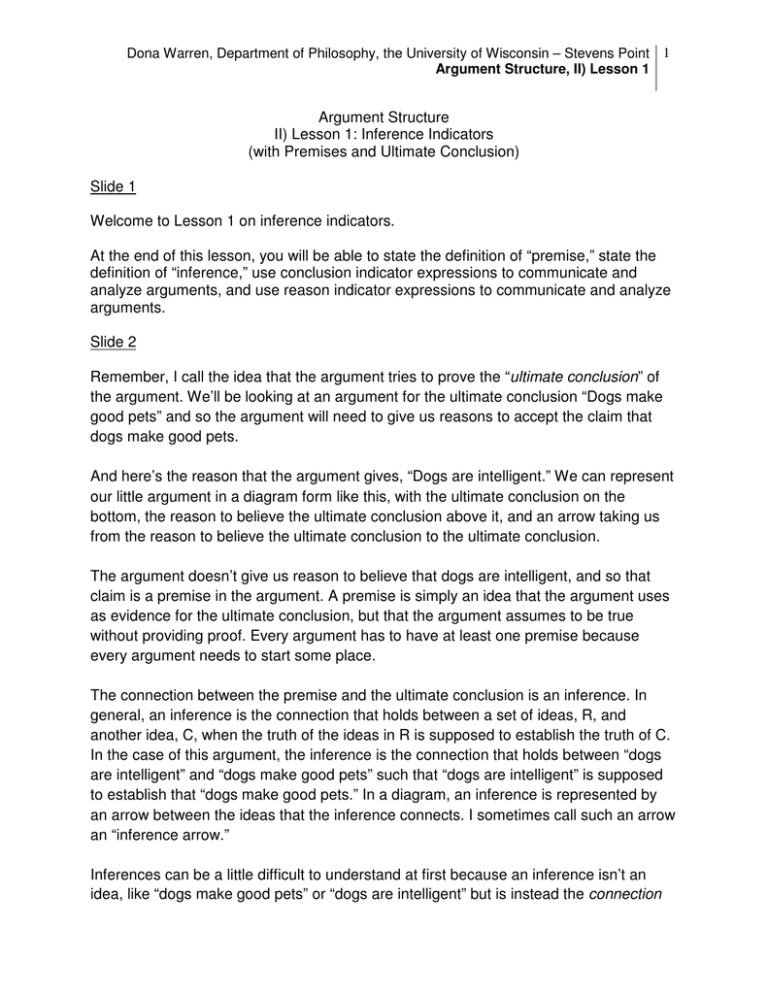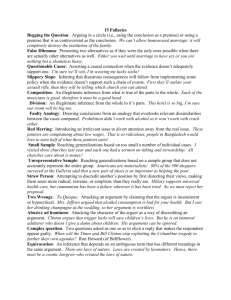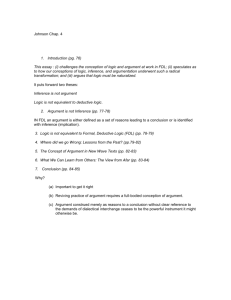Argument Structure II) Lesson 1: Inference Indicators (with Premises and Ultimate Conclusion)
advertisement

Dona Warren, Department of Philosophy, the University of Wisconsin – Stevens Point 1 Argument Structure, II) Lesson 1 Argument Structure II) Lesson 1: Inference Indicators (with Premises and Ultimate Conclusion) Slide 1 Welcome to Lesson 1 on inference indicators. At the end of this lesson, you will be able to state the definition of “premise,” state the definition of “inference,” use conclusion indicator expressions to communicate and analyze arguments, and use reason indicator expressions to communicate and analyze arguments. Slide 2 Remember, I call the idea that the argument tries to prove the “ultimate conclusion” of the argument. We’ll be looking at an argument for the ultimate conclusion “Dogs make good pets” and so the argument will need to give us reasons to accept the claim that dogs make good pets. And here’s the reason that the argument gives, “Dogs are intelligent.” We can represent our little argument in a diagram form like this, with the ultimate conclusion on the bottom, the reason to believe the ultimate conclusion above it, and an arrow taking us from the reason to believe the ultimate conclusion to the ultimate conclusion. The argument doesn’t give us reason to believe that dogs are intelligent, and so that claim is a premise in the argument. A premise is simply an idea that the argument uses as evidence for the ultimate conclusion, but that the argument assumes to be true without providing proof. Every argument has to have at least one premise because every argument needs to start some place. The connection between the premise and the ultimate conclusion is an inference. In general, an inference is the connection that holds between a set of ideas, R, and another idea, C, when the truth of the ideas in R is supposed to establish the truth of C. In the case of this argument, the inference is the connection that holds between “dogs are intelligent” and “dogs make good pets” such that “dogs are intelligent” is supposed to establish that “dogs make good pets.” In a diagram, an inference is represented by an arrow between the ideas that the inference connects. I sometimes call such an arrow an “inference arrow.” Inferences can be a little difficult to understand at first because an inference isn’t an idea, like “dogs make good pets” or “dogs are intelligent” but is instead the connection Dona Warren, Department of Philosophy, the University of Wisconsin – Stevens Point 2 Argument Structure, II) Lesson 1 between these ideas. We can think of an inference as the magnetic pull between these ideas. Inferences, like magnetic pulls, can be strong or weak. An inference is strong when the idea on top gives us very good reason to believe the idea on the bottom. An inference is weak when the idea on top doesn’t give us very good reason to believe the idea on the bottom. Slide 3 Inferences are often (although not always) signaled by inference indicator expressions when an argument is written or spoken. We might, for instance, write the argument that we’ve just seen as: “Dogs are intelligent. Therefore they make good pets.” In this passage, the inference is indicated by the word “therefore.” When two ideas are connected with “therefore” like this, the first idea is being given as a reason to believe the second. This makes the second idea the conclusion of that inference. Because “therefore” introduces conclusions, we call it a “conclusion indicator expression.” There are a number of conclusion indicator expressions, including “therefore,” “thus,” “consequently,” “hence,” “so,” “this goes to show that,” “it follows that,” “as a result,” “that’s why,” “which implies that,” and “which means that.” All of these expressions are like signs that say “Here comes a conclusion.” We don’t need to use conclusion indicator expressions when we write an argument, however. We could, for example, write our argument like this: “Because dogs are intelligent, they make good pets.” In this passage, the inference is indicated by the word “because.” When two ideas are connected with “because” like this, the idea that immediately follows “because” is being given as a reason to believe the second idea. This makes the first idea the reason in that inference. Dona Warren, Department of Philosophy, the University of Wisconsin – Stevens Point 3 Argument Structure, II) Lesson 1 Not surprisingly then, we call words like “because” “reason indicator expressions.” They work like signs that say “Here comes a reason” – and they work like that no matter where they show up in the sentence. We could, for instance, have written our argument as “Dogs make good pets because they are intelligent.” Here, the “because” appears between the two ideas. As before, however, “because” says “here comes a reason” and so the second idea is a reason to believe the first. This is worth discussing a bit. When a reason indicator appears between two ideas in a sentence, it tells us that idea following the reason indicator is being given as a reason to believe the idea preceding the reason indicator. We sometimes say that the first idea (the idea before the reason indicator) logically follows from the second idea (the idea after the reason indicator). Consequently, in passages like this, the ideas are presented in a way that effectively runs in the opposite direction of the inferential connection between them. Although the second idea follows the first idea in the passage, the first idea logically follows from the second. This can be confusing and so it’s important to be on the alert for reason indicator expressions that appear between two ideas in a sentence, and to remember that such an expression introduces the reason, making the second of these ideas the reason to believe the first. And just as there are a variety of conclusion indicator expressions, there are more reason indicator expressions than “because.” “Because,” “since,” “given that,” “assuming that,” “inasmuch as,” “in view of the fact that,” “the reason is that,” and “after all” are all reason indicator expressions. Slide 4 So far, we’ve seen how we can take a diagrammed argument and construct a passage containing that argument. The ability to do this is very useful for communicating our own arguments, for example, when writing. Now we’ll see how we can take a passage containing an argument and construct a diagram for it. The ability to do this is very useful for understanding other people’s arguments, for example, when reading. Dona Warren, Department of Philosophy, the University of Wisconsin – Stevens Point 4 Argument Structure, II) Lesson 1 Slide 5 Let’s start with the passage “Cats are easy to care for. Thus, they make good pets.” The first thing we might notice is the conclusion indicator expression “thus.” This will correspond to an inference arrow in the diagram. As we’ve seen, a conclusion indicator expression acts like a sign that says “Here comes a conclusion.” This tells us that the idea after “thus,” “cats make good pets,” is the conclusion of the argument, and makes “Cats are easy to care for” the reason given to believe this conclusion. We’ve finished diagramming the argument! Now let’s consider another passage containing an argument: “Cats are easy to care for since they are independent.” The first thing we might notice here is the reason indicator expression “since.” This will correspond to an inference arrow in the diagram. As we’ve seen, a reason indicator expression acts like a sign that says “Here comes a reason.” This tells us that the idea after “since,” “cats are independent,” is a reason to believe something else in the argument. And what idea is supposed to be supported by the claim that cats are independent? The claim that cats are easy to care for. That, then, is the conclusion of this argument. This concludes Lesson 1. You may now proceed to the “Gauge Your Understanding” exercises and then continue with Lesson 2.



